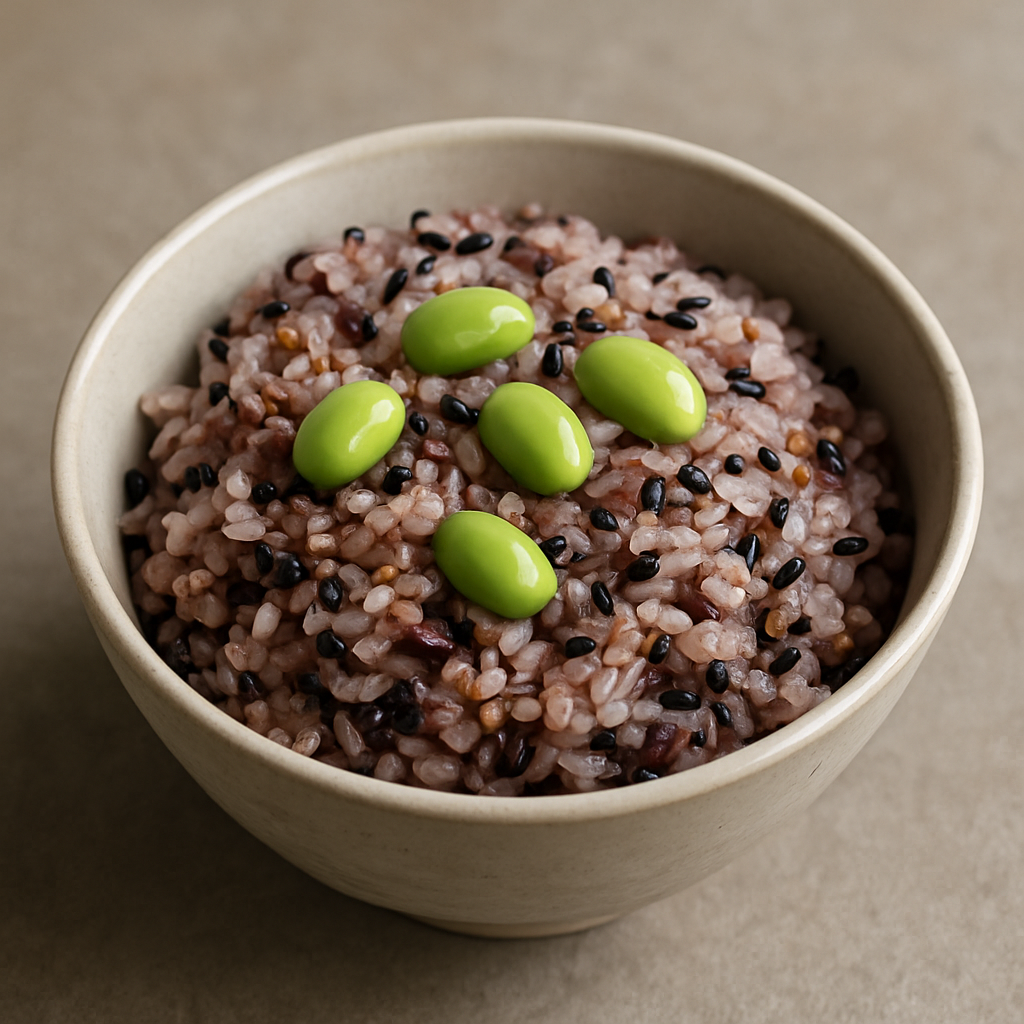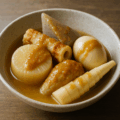ごまごはんの特徴
津軽に伝わる“色飯(いろめし)”のひとつ
津軽地方では、具を加えて醤油味に仕立てたご飯を「色飯/色ごはん」と呼びます。「ごまご飯(ごままんま/ごままま)」もその一種で、黒ごまを利かせた香ばしさが持ち味です。仏事や精進日の“ケの日”に供えられる一方、砂糖を入れて甘く作り、赤飯の代わりに祭礼や田植えのもてなしに用いられる地域もあります。栗を加えた豪勢な「栗入りごままま」も知られています。
炒りごまを混ぜて蒸し上げるおこわ風
から炒りして粗くすった黒ごまをもち米に混ぜ、打ち水(砂糖・醤油入り)を加えて蒸し上げるおこわ風の製法。湯気にのるごまの香りが食欲をそそります。
ごまごはんのレシピ
材料(6人分)
- もち米 … 200mlカップで3カップ
- 黒ごま … 30g
- 砂糖 … 40g
- 醤油 … 大さじ2と1/2
- 打ち水用の水 … 250ml
- 枝豆 または 栗の甘露煮 … 適量(仕上げ)
出典:農林水産省「うちの郷土料理」/レシピ提供:柴田学園大学短期大学部 北山育子氏。
作り方
- もち米は洗い、前の晩から浸水。翌朝ざるに上げて水気を切る。
- 黒ごまはから炒りし、すり鉢で粗くする。
- 打ち水用に、水250mlへ砂糖と醤油を混ぜておく。
- 蒸し器に濡らした蒸し布を敷き、もち米を入れて強火で20分蒸す。
- 一度ボウルにあけ、黒ごまと打ち水を加えてよく混ぜる。
- 再び15分蒸す。
- バットに広げてうちわであおぎ艶を出し、枝豆または栗の甘露煮を散らす。
(地域や家庭で配合・作法に違いがあります。)
シェフのワンポイントアドバイス
黒ごまは「香りが立つ直前」までしっかり炒ってから粗くするのがコツ。
打ち水は一度に加えず、様子を見ながら2~3回に分けて混ぜるとムラなく仕上がります。
甘みを強めたい行事向けは砂糖を少し増やし、日常向けは控えめに。
食べ方・背景
行事と日常に寄り添う“香ばし甘口”のご飯
仏壇へのお供えや精進日に作られたほか、田植えの人寄せや祭りのもてなしに甘く仕立てた「ごままんま」を握って携行したと伝わります。色飯には他に小豆飯や黒豆飯、赤飯などもあり、地域の食文化として受け継がれています。
丁寧に作れば、ごまの香りとおこわの艶で“ほっとする一椀”に。今日もすてきに仕上がりますように—応援しています!
English Version
Features of Goma Gohan (Sesame Rice)
One of Tsugaru’s “iromeshi” (seasoned colored rice)
In the Tsugaru area, rice cooked with seasonings and add-ins is called iromeshi (“colored rice”). Goma gohan—also known as gomamamma—is one such dish, prized for the aroma of black sesame. It’s offered on Buddhist observance days, and in some communities it’s sweetened and served in place of red rice for festivals or rice-planting hospitality. A more festive version with chestnuts (kuri-iri gomamamma) is also known.
Sticky-rice “okowa” style, steamed with toasted sesame
Coarsely ground, dry-toasted black sesame is mixed into soaked glutinous rice. A “sprinkling water” of soy sauce and sugar is added, then the rice is steamed to a glossy, gently sweet finish. The sesame fragrance rising with the steam is irresistible.
Recipe
Ingredients (serves 6)
- Glutinous rice … 3 rice cups (200 ml each)
- Black sesame seeds … 30 g
- Sugar … 40 g
- Soy sauce … 2½ tbsp
- Water for sprinkling … 250 ml
- Edamame or candied chestnuts … to taste (for finishing)
Source credit: “Our Regional Cuisines (Aomori)” MAFF / Recipe by Ms. Ikuko Kitayama, Shibata Gakuen Junior College.
Instructions
- Rinse the glutinous rice and soak overnight. Drain well the next morning.
- Dry-toast the black sesame and grind coarsely in a mortar.
- Make the sprinkling liquid by mixing the 250 ml water with sugar and soy sauce.
- Line a steamer with a damp cloth, add the rice, and steam over high heat for 20 minutes.
- Transfer the rice to a bowl; add the sesame and the sprinkling liquid, mixing thoroughly.
- Return to the steamer and steam for another 15 minutes.
- Spread on a tray, fan to a sheen, and finish with edamame or candied chestnuts.
(Ratios and methods vary by household and district.)
Chef’s Tips
Toast the sesame right up to the point where the aroma blooms, then grind coarsely. Add the sprinkling liquid in 2–3 rounds while mixing so the seasoning distributes evenly. For ceremonial use, increase the sugar slightly; for everyday meals, keep it lighter.
Serving & Background
A fragrant, gently sweet rice for rituals and daily meals
Besides offerings on Buddhist observance days, people would shape sweet gomamamma into onigiri for fieldwork gatherings and festivals. Other local “colored rice” include adzuki rice, black-bean rice, and celebratory red rice—each part of Tsugaru’s food culture.
Made with care, the sesame aroma and glossy okowa texture bring comfort to the table. Wishing you a beautiful finish today!



何でも質問してください!